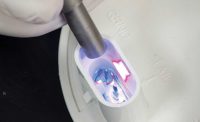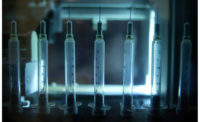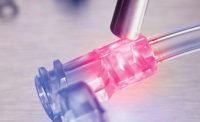Worldwide, sales of smart phones and tablet computers have skyrocketed. A report by Credit Suisse predicts annual sales of smart phones will cross the 1
|
Jump to: Curing with Arc Lamps LED Curing Systems Curing LOCAs |
billion mark in 2014, driven by the launch of lower-end handsets and increasing demand from China. Tablet computers are also experiencing rapid growth. Forrester Research projects sales of tablet computers to grow from 56 million in 2011 to 375 million in 2017, a compound annual growth rate of 46 percent.
The demand for mobile computing has, in turn, driven explosive growth for LCD touch-panel displays. According to research firm Display Search, 1 billion touch panel devices were shipped in 2011, and the market is forecast to grow at a compound annual rate of 15.6 percent through 2016.
As the market for mobile computing expands, more vendors have entered the picture, which has resulted in increased competition and price compression. The demand for lower prices and better quality is pressuring manufacturers to drive out costs and improve yields during assembly.
Mounting sensitive touch-panel displays is a critical step in the assembly of smart phones and tablet computers. One method of assembly involves using optically clear adhesive tape to permanently fix components. This method produces high yields, but sacrifices optical quality and durability. It also requires flat surfaces, and it becomes difficult to implement with larger displays.
Another method of assembly uses liquid optically clear adhesives (LOCAs) cured with high-power ultraviolet (UV) light sources, most commonly mercury arc lamps. LOCAs provide higher optical quality in a touch-panel display, and they work well with a range of surface sizes and with uneven surfaces.
However, the process yield with LOCAs can be lower than with optically clear tape. The lower yield is caused, in part, by local heating from the arc lamps used to cure the adhesive. Rework of the display after final cure is not possible.
Now, a new technology—high-power LEDs—is emerging as an alternative to mercury arc lamps for curing LOCAs. Compared with arc lamps, LEDs offer potentially higher yields and improved quality without compromising throughput. LEDs may also provide process yields that equal or exceed those achieved using optically clear tape, while providing better optical quality and more flexibility for use on a wide range of surfaces.
Curing With Arc Lamps
A long-established technology, mercury arc lamps produce light from the UV to the infrared by generating an electric arc inside a glass tube containing atomic mercury. Many UV-curable adhesives have been formulated with photoinitiators to absorb light from mercury arc lamps, particularly the strong emission at 365 nanometers (nm).
While high-irradiance mercury arc lamps are widely deployed in touch-panel manufacturing systems, they have several drawbacks. The most serious involves heating at the cure site. Less than 20 percent of the light from an arc lamp contributes to curing, so a significant portion of wasted light is absorbed and converted to heat in the adhesive and substrate. A fraction of light at 365 nm is also absorbed by the display material and reradiated as heat. Additional heat from infrared light generated by the lamp is also delivered to the curing site. These combined sources of heat can damage and discolor both the substrates and the adhesive.
Another drawback is lamp life. With typical lifetimes of just 3,000 hours, mercury arc lamps must be replaced frequently. Arc lamps also draw significant electrical power and produce ozone emissions that require dedicated venting. Since mercury is toxic, the lamps pose a threat to the environment and are difficult to dispose of at end of life.
What’s more, the primary wavelength emitted from the lamps, 365 nm, can be attenuated by many materials used in tablet displays, including glass and plastic windows, polarizers and indium tin oxide (the thin layer of conductive material on the window). This can reduce UV irradiance at the adhesive layer and increase processing times.
LED Curing Systems
LEDs are an alternative to arc lamps for curing LOCAs. Like semiconductor lasers, LEDs generate narrow-bandwidth light by injecting electrons at a semiconductor junction. They are much more electrically efficient than arc lamps, and they do not produce ozone, so do not require dedicated venting. Used extensively in consumer and telecommunications products, LEDs have evolved to become a robust and reliable platform for generating high-brightness radiation at a wide range of wavelengths.
For curing UV-sensitive adhesives, LEDs offer many improvements over arc lamps, including:
- Lower operating costs as a result of longer lifetimes—up to 20,000 hours compared to 3,000 hours for mercury arc lamps.
- Lower power consumption.
- Faster on-off switching without external shutters.
- Easier disposal. Unlike mercury lamps, LEDs contain no toxins.
- Ozone-free operation.
LEDs can also offer a degree of flexibility, because they can be fabricated to operate at a range of UV and visible wavelengths. Commercial LED curing systems are available to produce wavelengths of 365, 385 and 400 nm. The nearly monochromatic light from LEDs is almost entirely absorbed by the adhesive, so heating effects are greatly reduced.
There is, however, a trade-off to consider with LED systems. Because of challenges in engineering the LEDs themselves, peak irradiance depends on the wavelength. Shorter wavelength LEDs have lower optical power, which means 385-nanometer LEDs have higher irradiance and power than 365-nanometer LEDs, and 400-nanometer devices typically have the highest irradiance and optical power of all.
Curing LOCAs
The higher optical power of 400-nanometer LEDs would be of little use if the light cannot be absorbed by the adhesives used in tablet displays. Fortunately, the absorption of many photoinitiators extends over a broad range of wavelengths, including 400 nm. Even if absorption by a photoinitiator is not as strong at 400 nm as it is at 365 nm, the higher irradiance often compensates for the difference. In addition, many components in tablet displays have higher transparency at 400 nm, so LEDs at this wavelength may offer faster and more uniform cures than 365- or 385-nanometer LEDs, or even high-power mercury arc lamps.
To determine the effectiveness of 400-nm LEDs, we tried curing several off-the-shelf LOCAs from major manufacturers using the OmniCure LC280. Specifically designed for curing LOCAs in tablet displays, this air-cooled system is equipped with 400-nm LEDs and achieves a peak irradiance of 5 watts per square centimeter (W/cm2) at a working distance of 10 millimeters. With a custom-designed optical element, the system can produce a peak irradiance of 3 W/cm2 at a working distance of 30 millimeters, which allows for easier integration into automated systems. The effective bonding area of the system is 260 millimeters by 15 millimeters.
Figure 2 shows how well a LOCA cured after several scans with the LC280 at a working distance of 30 millimeters. Each scan provided a dose of 800 millijoules per square centimeter at a speed of 8 centimeters per second.
The curves show optical transmission through the adhesive. The lower transmission in the 350 to 400 nm range is caused by the presence of photoinitiators in the adhesive. Each pass with the LED head consumes more photoinitators and advances the cure, as shown by the increasing transmission of 350 to 400 nm light after each scan. After three to four scans, the absorption no longer changes. This indicates that the photoinitiators have been fully consumed and the cure is complete.
The LC280 cured some 70 percent of the adhesives we tested, passing structural tests specified by the adhesive manufacturers. The temperature of the parts in the tablet display remained below 40 C—well below the threshold for heat-induced damage or discoloration to occur.
The LC280 achieved scanning speeds that compare favorably with production speeds achieved using mercury arc lamps. With lamps, process speeds of 0.1 to 5 centimeters per second are possible, depending on working distance and adhesive. With the LC280, process speeds of 1 to 5 centimeters per second were achieved. Therefore, process speeds with 400-nm LEDs can equal or better the results achieved with arc lamps without sacrificing quality.






